Chaise longue
A chaise longue (/ʃeɪz ˈlɒŋ, tʃeɪz-, -ˈlɒ̃ɡ/;[1] French: [ʃɛz lɔ̃ɡ], "long chair") is an upholstered sofa in the shape of a chair that is long enough to support the legs.

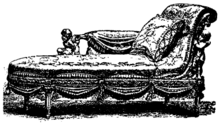
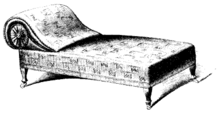
In modern French the term chaise longue can refer to any long reclining chair such as a deckchair. A literal translation in English is "long chair". In the United States the term lounge chair is also used to refer to any long reclining chair. In the United States, chaise longue is often written "chaise lounge" and pronounced /ˌtʃeɪsˈlaʊndʒ/, the first constituent a spelling pronunciation, the second a 19th-century folk-anagrammatic adaptation of French longue.[1]
Origins
The modern chaise longue was first popularised during the 16th Century in France. They were created by French furniture craftsmen for the rich to rest without the need to retire to the bedroom. It was during the Rococo period that the chaise longue became the symbol of social status and only the rarest and most expensive materials were used in their construction. Today, the chaise longue is seen as a luxury item for the modern home. They are often used to complement a home's décor such as living or reading rooms, or as a stylish boudoir chair for bedroom seating.[2]
- Duchesse brisée (Broken duchess in French): this word is used when the chaise longue is divided in two parts: the chair and a long footstool, or two chairs with a stool in between them.[3] The origin of the name is unknown.
- Récamier: a récamier has two raised ends, and nothing on the long sides. It is sometimes associated with French Empire (neo-classical) style. It is named after French society hostess Madame Récamier (1777–1849), who posed elegantly on a couch of this kind for a portrait, painted in 1800 by Jacques-Louis David. The shape of the récamier is similar to a traditional lit bateau (boat bed) but made for the drawing room, not the bedroom.[3]
- Méridienne: a méridienne has a high head-rest, and a lower foot-rest, joined by a sloping piece. Whether or not they have anything at the foot end, méridiennes are asymmetrical day-beds. They were popular in the grand houses of France in the early 19th century. Its name is from its typical use: rest in the middle of the day, when the sun is near the meridian.[3][1]
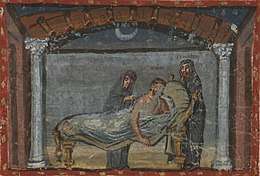 Chaise longue (Klinai) in a 4th-century Roman manuscript
Chaise longue (Klinai) in a 4th-century Roman manuscript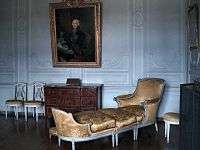 Duchesse brisée
Duchesse brisée Récamier
Récamier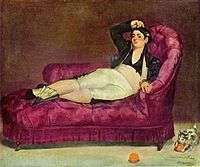 Méridienne
Méridienne
Psychoanalysis

The chaise longue has traditionally been associated with psychoanalysis. Sigmund Freud initiated the use of the chaise longue for this purpose, with the idea being that the patient would recline on a couch, with the analyst seated beyond the head of the couch, so that the client would not see the analyst. Reclining and not having to face the analyst was thought to be disinhibiting and to encourage free association. At the time Freud began to use the chaise longue, it was considered daring in Vienna to recline on a chaise in the presence of non-intimates. Freud's own chaise longue, given to him by a patient, may be seen today at the Freud Museum in London.[4]
Today, psychoanalysts continue to invite clients to recline on couches in their offices during psychotherapy, and may use chaises longues rather than more conventional styles of couch out of tradition. The chaise longue is used to suggest a generic psychotherapist's office in cartoons and other works.[5]
See also
References
- "Chaise longue". Dictionary.com. 2009-08-15. Retrieved 2017-04-04.
- "History of the chaise longue - The Chaise Longue Co". www.thechaiselongueco.co.uk. Retrieved 2019-07-31.
- "Is a Recamier the Same as a Chaise Longue?". HammockStandPro.com. Archived from the original on 8 September 2017. Retrieved 26 June 2019.
- Cook, William (21 August 2006). "Analysing Freud's couch". The Guardian. Retrieved 23 May 2020.
- Blundy, Anna (16 June 2016). "Life of the mind: The importance of the couch". Retrieved 23 May 2020.
External links
| Wikimedia Commons has media related to Chaise longue. |
- Segal, Troy (23 April 2019). "All About American and European Daybeds". The Spruce Crafts, Dotdash. Retrieved 26 June 2019.